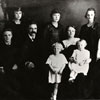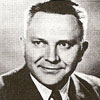Kask Family
 John Michael Kask and his wife Minnie Piht emigrated from Maasi Vald, Saaremaa in Estonia to Staten Island, New York in the late 1890s. Juhan operated a modest shipbuilding business in New York City but the promising lure of free land in western Canada took the family to Sylvan Lake in 1900. The Kasks were the second Estonian pioneer family to settle at Sylvan Lake. During the next few years, John and Minnie's siblings left Estonia to join pioneer homesteaders. Vassily, Michael Piht, and Anton and Aleksei (Alex) Kask, and Elizabeth Kask Wortnow and her husband Michael all arrived in Red Deer in 1901 and walked miles to their designated homestead.
John Michael Kask and his wife Minnie Piht emigrated from Maasi Vald, Saaremaa in Estonia to Staten Island, New York in the late 1890s. Juhan operated a modest shipbuilding business in New York City but the promising lure of free land in western Canada took the family to Sylvan Lake in 1900. The Kasks were the second Estonian pioneer family to settle at Sylvan Lake. During the next few years, John and Minnie's siblings left Estonia to join pioneer homesteaders. Vassily, Michael Piht, and Anton and Aleksei (Alex) Kask, and Elizabeth Kask Wortnow and her husband Michael all arrived in Red Deer in 1901 and walked miles to their designated homestead.
Working collectively was paramount for the Kasks; doing so allowed them to adapt to the challenging life of homesteading. The Kasks frequently participated in numerous community initiatives and established co-operatives for their mutual benefit. Maintaining a convivial relationship with the local Estonian community was crucial to overcoming the language barrier present in the public sphere. Members of immigrant families would accept jobs in construction and mining to provide for their families. The Kask's, for instance, worked in Red Deer's brickyard and in various lumber camps scattered throughout the area. Many Estonian families including the Kask's, helped build the western branch lines of the Canadian Pacific Railway. Incidentally, the Pihts soon changed their surname to Walters after Vassily was mistakenly called "Pete" by co-workers who thought Piht was his first name. Juhan was instrumental in organizing a school district. He donated two acres of land for the Norma Public School, thereby facilitating its opening in 1903.
In 1908 the Kask's moved to Port Essington, British Columbia where John was eager to begin work on the railways. Five years later Juhan, Minnie, and the four children, eager to reunite with friends and family they had left behind years earlier, returned to Estonia. Estonia's political instability and the impending war forced the Kask's to migrate to Canada. They settled in Tofield, Alberta and built a grist mill with friends and family. Aptly named the Kask & Walters Grist Mill and Carpentry Shop, the flour and wood-making shop was a successful enterprise.
Restless and ambitious, John moved his family back to Prince Rupert in 1919. Seeking new opportunities, he left Canada for Siberia in 1923 to establish a mining and agricultural co-operative. Meanwhile, the family moved to Vancouver. After only a short time in Siberia, John Kask died of pneumonia. He was 52. His wife Minnie died years later at the age of 83. The first generation of Kask children married and settled in various parts of western Canada.
 Receiving a proper education was of utmost importance to the Kask's. In fact, Marie Kask was the first woman to graduate with a Master of Arts from the University of Alberta. Her brother John Laurence (Jack) went on to pursue a career in marine biology and oceanography.
Receiving a proper education was of utmost importance to the Kask's. In fact, Marie Kask was the first woman to graduate with a Master of Arts from the University of Alberta. Her brother John Laurence (Jack) went on to pursue a career in marine biology and oceanography.
Of the original homesteaders, only Vassily Piht (his wife Alma and their two daughters) and Alex Kask's family (his wife Anna and their two children) stayed in the Sylvan Lake area.








